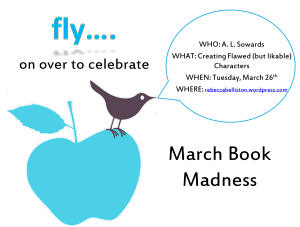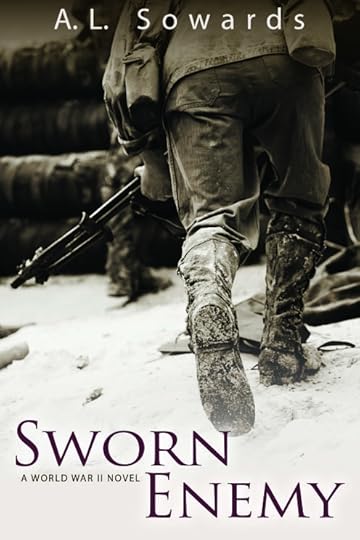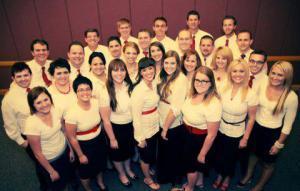A.L. Sowards's Blog, page 13
April 30, 2013
Sweeney Todd, Sherlock Holmes, and Stephen Ambrose

April 18, 2013
Sworn Enemy Launch

March 26, 2013
March Madness: Creating Flawed (but likeable) Characters
No, I’m not writing about basketball (sorry). I’m writing about writing, over at a friend’s blog. I hope you’ll take a moment to visit her sight. All month she’s been having other writers share some insight, and today I get to talk about one of the best parts of fiction writing: creating characters.
You can click the picture above or follow this link:http://rebeccabelliston.wordpress.com/2013/03/26/mbm-creating-flawed-but-likeable-characters-by-a-l-sowards/
Filed under: Uncategorized


February 26, 2013
Cover Reveal: Sworn Enemy
Here’s the cover for my new novel coming out in April:
And here’s what will appear on the back cover:
June 1944: As World War II rages, the people of Eastern Europe are hopelessly trapped between two formidable forces: Hitler’s Germany and Stalin’s Soviet Union. In their midst, a band of heroes works to defend against the inevitable Communist takeover.
After narrowly escaping her Nazi captors, French Resistance worker Genevieve Olivier has fled to Allied territory with the help of American Lieutenant Peter Eddy. Their connection is undeniable, forged in the crucible of danger. But despite their blossoming feelings for each other, they must both finish the work they began . . .
In the safety of England, Genevieve hopes to find purpose as a nurse—all the while unaware that the Gestapo still seeks the woman who slipped through their grasp. When she is called upon to resume a life of danger as a French spy, will her desire to prove herself be her downfall?
Recruited by an elite special-ops team intent on thwarting the Nazis, Peter finds himself engaged in a personal battle as well—there is a traitor among his comrades. Deep in the Carpathian Mountains, Peter combats an unknown foe. The stakes are high as he fights to save the lives of his teammates.
They are miles apart, yet as Genevieve and Peter fight for their own survival, they find a common well of strength in their faith—and their determination to be reunited.
It’s always exciting to get a new cover, and I like this one. What do you think? If you were browsing in a bookstore, would you pick the book up to learn more?
I think that’s a BAR, a Browning Automatic Rifle, in the man’s hands. I’m hoping a few readers who know more about firearms than I do can confirm or correct me. Also, I’m doing some updates to the website, so if you notice anything that’s not formatted correctly, I’d love a quick message telling me to fix it. Thanks!
Filed under: Sworn Enemy, Writing, WWII


February 14, 2013
Guest Post by Author Stephanie Worlton on the Importance of Education
Today I’m happy to have Stephanie Worlton as a guest on my blog. Stephanie is the author of the novel Hope’s Journey, and recently released her second book, a nonfiction guide called Everything You Need to Know About Girls Camp. I asked Stephanie to share her thoughts on the importance of history and education.
 Education: I thought I knew it all
Education: I thought I knew it all
When I was a little girl, I had my whole life mapped out. I knew exactly where I was going to live, what my family would be like, and what I was going to do for a living. Because education was an integral part of making that plan work, I always took my schooling seriously. My degree was math and art intensive, so naturally I spent a lot of time seeking that type of knowledge. I fulfilled my General Ed requirements strictly out of necessity.
Just a few years down the road, however, I began to realize how important and valuable all those Gen Ed classes were.
I had my eye on a career in Architecture but life, as it often does, had a different path for me. For a long time I thought I’d fulfill my “mommy duties” then return to the world of design. Becoming a published author, however, was about the furthest thing from my mind.
Then something happened. A love of books and a longing to create burned inside me. When the opportunity to become published presented its smiling face, I was sure glad I’d attained enough knowledge and education to do so. The same can be said of the historical knowledge I’ve acquired over the years. While my current path may not seem to hinge on my historical knowledge, my pursuit of historical information and stories bares heavy influence on my writing. And, when I’m not writing, that love of history enriches my life and provides me a foundation for which to base political, social and personal decisions.
My advice to readers young and old: Don’t ever stop learning. Life is full of twists and turns, ups and downs, and paths that may open only if you are prepared for them. The pursuit of knowledge, whether formal or not, should be a continual quest. Strive to learn something new every day. There is never any harm in self-improvement and no reward as great as having the keys you need to open the doors of opportunity that stand in front of you.
Thank you so much, Stephanie, for sharing your thoughts. Your advice “Don’t ever stop learning” is golden!
Stephanie is currently on blog tour for her new book, Everything You Need to Know About Girls Camp, and she’s also having a book launch party this Saturday, February 16, from 1 to 4pm at the Seagull Book at the District, 11531 District Drive, in South Jordan, UT. You can learn more about Stephanie on her blog, Kreating Krazy, or read an interview I did with her last year. As part of her blog tour, Stephanie is giving away a copy of her new book. You can enter by clicking here or by visiting her blog. Her book can be purchased in bookstores and online Amazon, Barnes and Noble, and Deseret Book.
Thank you for being a part of my blog, Stephanie, and good luck with your newest book!
Filed under: Author Interviews, Reading


February 8, 2013
What’s in a Name? Part Two: Commander Courage and Other Names That Border on Perfection
I recently read an article about the first naval battle of Narvik, which took place in April 1940 between British and German ships in Ofotfjord (also called Narvik Fjord) in Norway. I won’t give a detailed blow-by-blow of the battle, but I’ll give you a summary. I also found a map in the public domain, and it even shows some of the shipwrecks.
At the time, Norway was officially neutral, and Narvik was a vital stop on the route Sweden’s iron ore took on its way to Germany. Naturally, the British wanted to deny Germany access to this resource, and Germany wanted to secure it. Germany also wanted to prevent a British blockade similar to what had happened during WWI.
Despite Norway’s official neutrality, the Royal Navy was laying mines in Norwegian waters, and Germany sent a portion of their fleet into Ofotfjord, sunk two of Norway’s warships, landed troops on the ground, and invaded Narvik.
Wary of the Royal Navy, the German Navy planned a quick trip back to more friendly waters, but the Norwegians had managed to sink one of their two tankers, so the refueling took twice as long. While five German destroyers stayed in Narvik harbor, five others hid in other areas of the fjord.
Meanwhile, five Royal Navy destroyers entered Ofotfjord in a snowstorm. They were H-class, thus their names: Hardy, Hunter, Havock, Hotspur, and Hostile. (I love the names, but I also found it easy to be confused by them–I wonder if their opponents had the same problem?) They attacked the German destroyers refueling at Narvik and sunk or damaged several of them.
Here’s where we get into the interesting names, first with the British destroyers, then with the Havock’s skipper, Lieutenant Commander Rafe E. Courage. I wonder if having a skipper with a name like Courage was an automatic boost to morale. (I’m sure sinking a German destroyer also helped in the morale department.)
The British destroyers regrouped and went back for another run at the German ships. But they didn’t know that the there were five additional German destroyers in Ofotfjord, and they were soon caught in a trap.
Though it wasn’t commanded by someone with the last name of Courage, I was impressed with what happened next aboard the Hardy. On the Hardy was Captain Warburton-Lee, the flotilla’s leader. The last orders he gave were to “Keep on engaging the enemy.” Then a German shell struck Hardy’s bridge and killed Warburton-Lee and everyone else on the bridge, with the exception of Lieutenant Geoffrey Stanning. Despite his broken leg, Stanning climbed down a ladder (ouch!) and used the damaged wheel to steer the ship. He was going to ram one of the German destroyers, but when the Hardy took another hit, he decided to beach the ship instead, and was thus able to save most of the crew. Stanning is a hero in my book.
The battle continued on for a while, and in the end, the British had lost two destroyers and one other ship, and the Germans had lost two destroyers and six other ships. There was another naval battle of Narvik a few days later, but that’s a story for another blog post. In the end, Germany occupied Norway for the remainder of the war. In fact, I read recently that as late as May 1945—after Hitler’s death—a few Nazi generals (Keitel and Jodl) had plans to flee to Norway and continue the fight there. Fortunately, they didn’t make it.
Keeping with the interesting names theme, I have a character with the last name of Weiss who appears in Espionage and in Sworn Enemy. It means “white,” but if you pronounce it in German, it sounds like “vice,” as in something bad. Or as in something that could be used to torture someone. Both fit the character. In Sworn Enemy, he’s promoted to Rottenführer Weiss. I couldn’t resist giving him a rank that looked like “rotten.”
Names can be interesting: five British destroyers starting with the letter “H,” Commander Courage, and the fictional Rottenführer Weiss. Do you have any examples of names that are almost perfect? Or that are too perfect?
On an unrelated tangent, the finalists for the 2012 Whitney Awards were announced this week, and Espionage is one of the historical fiction finalists. You can find the others at the Whitney Awards website. If you’re looking for a good fiction read, the Whitney lists are a good place to start—find your favorite genre and read away!
Filed under: Espionage, History, Sworn Enemy, Whitneys, WWII


February 2, 2013
What’s in a Name? Part One: Paulus and Paullus
Seventy years ago today, on February 2, 1943, the last German troops in Stalingrad surrendered.
The fight for Stalingrad was huge in terms of lives lost and prisoners taken. (Estimates of total casualties vary, but are somewhere between one and two million.) It’s easy to argue that the German defeat on the Russian steppes was the most important turning point in World War II. Probably bigger than D-day or El Alamein or Midway.
In 1942, German strategy with its Army Group South was to take the oil fields in the Caucasus. As part of this campaign, the Germans needed to secure the area between the Don and Volga rivers, including the city of Stalingrad. German troops entered the city on September 12. They outnumbered the Soviet defenders, but every building (and often every room in every building) became a struggle. Both sides suffered heavy losses, but by mid-November, Germans forces had managed to take almost 90% of the city.
On November 19, the Soviets launched a counteroffensive on the steppes west of Stalingrad. Soviet troops moving from the north and from the south succeeded in encircling the German Sixth Army and their allies from Romania, Italy, and Hungary. At that point, the German army probably could have broken out, withdrawn, and regrouped. But Hitler refused to let them leave. Goering’s promise of resupply by air failed miserably, and an attempted relief offensive led by General von Manstein was turned back by the Soviets.
Slowly, the German men and their allies inside the Soviet ring lost ground. They were surrounded, starving, running out of ammunition, and facing determined Soviet advances and a freezing Russian winter. Bit by bit, the noose was tightened, and more soldiers fell. About 110,000 German troops surrendered during the last days of the battle. Less than 6,000 returned home.
The Nazis had lost in the east. The end would take another two years, but the Nazi Empire had reached its high-water mark and from then on would shrink.
The leader of the German Sixth Army was General Friedrich von Paulus. Last fall, while I was reading a book about Stalingrad (Enemy at the Gates—recommended if you like nonfiction history books), my husband was reading up on his Roman history, specifically the wars against Carthage.
The battle of Canae took place in what it now southern Italy on August 2, 216 BC. The Roman army faced their enemies from Carthage (and her allies), who were assembled in an arch. The Romans attacked the center, and almost broke through, but were drawn into the Carthaginian line. Their enemies attacked their flanks, the Roman army was surrounded, and 50-70,000 Romans (out of an army of 80-85,000) were slaughtered.
Carthage was led by Hannibal Barca. The Roman leaders were Tarentius Varro and Aemilius Paullus.
Paullus and Paulus. Both surrounded and their armies largely slaughtered. Does anyone else find that spooky?
Visit again next week for What’s in a Name, Part II.
Filed under: History, WWII


January 17, 2013
Author Interview with Kylee Shields
 I don’t often join blog tours for nonfiction, but after reading about Kylee’s book, Make It Happen: A Guide to Happiness for LDS Singles, I was interested. Though I am LDS, I am not single, but I gather part of Kylee’s message is the importance of making the best out of whatever phase of life you’re in. And that’s a reminder we can all use, isn’t it? Today I’m delighted to present this interview with Kylee, and to give you information about the giveaway she’s running as part of the blog tour (read all the way to the bottom to find out how to enter).
I don’t often join blog tours for nonfiction, but after reading about Kylee’s book, Make It Happen: A Guide to Happiness for LDS Singles, I was interested. Though I am LDS, I am not single, but I gather part of Kylee’s message is the importance of making the best out of whatever phase of life you’re in. And that’s a reminder we can all use, isn’t it? Today I’m delighted to present this interview with Kylee, and to give you information about the giveaway she’s running as part of the blog tour (read all the way to the bottom to find out how to enter).
What is your favorite book?
These are some of my favorite books and their authors. I also love reading the classics such as Poe, Dickens, Thorough, Emerson, and the powerhouse writers like J.K. Rowling & J.R.R. Tolkien. Tuesdays With Morrie by Mitch Albom, Making Loss Matter by Rabbi David Wolpe, Letters to a Young Poet by Rainer Marie Rilke, To Draw Closer to God by Henry B. Eyring, A Grief Observed by C. S. Lewis, The Alchemist by Paulo Coelho, The Chosen by Chaim Potok, Dandelion Wine by Ray Bradbury, On Writing by Stephen King
I love Diet Coke and Jelly Beans!
Favorite quote:
There are few quotes I keep coming back to but this is my currently favorite, “I had become a new person; and those who knew the old person laughed at me. The only man who behaved sensibly was my tailor: he took my measure anew every time he saw me whilst all the rest went in with their old measurements and expected them to fit me.” –George Bernard Shaw (1856-1950) Man and Superman, 1903–
If you had a time machine, when would you like to visit?
I would go back to the past. I think I would like to hang out with F Scott Fitzgerald, C.S. Lewis, Poe, Emerson, Thorough, and like minded artists, painters and writers. I would like to dance with Fred Astaire and sing with Frank Sinatra. I would have a typewriter and a record player, and when I went dancing it would be to a club where everyone knows how to waltz.
What do you like to do when you’re not writing?
I co-founded a non-profit singing/service group called INSPIRE:music.service.hope. I am the music director of the group and I LOVE it! I work as a adolescent therapist in a wilderness therapy program called ANASAZI and I am so grateful to have a job I love! I also love doing things with my roommates, reading, traveling, and spending time with my family.
Best writing advice you’ve ever received?
Stephen King, in his book, On Writing talks about the idea of “writing off the page.” I think great writers like Rawlings & Tolkien write off the page brilliantly. To create entire lives for your characters, entire worlds, languages, and at the same time write accessibly to a broad audience. He also shares that the best writers will write what they know. I really took that to hear for my nonfiction book.
Writing advice you’d give to others?
Keep writing and seeking your dream. There is so much to do and be a part of in the writing world. It used to be a writer’s dream to be published by some big name company but now there are so many options. You can self publish, be a blogger, write for a magazine, online books, poetry and so much more. MAKE IT HAPPEN!
What are you working on now?
I am working on a YA fiction novel about forgiveness, healing, and living your dreams.
What type of readers would like your book?
It was written for those who are experiencing life as a single adult but it has principles that can be applied to anyone. Some of my most positive feedback has come from people who are married and have children. Anyone who wants to be inspired to make changes in their lives and go out and make their dream a reality will like my book!
What process do you go through as you get a book ready for submission?
I have a very eclectic writing process. The following 3 pictures share a little bit about my writing story.

I sort of storyboarded my chapters on my wall for about a year. I moved them around and folded up the corners when that chapter was complete. This really motivated me.

I have many wicked awesome single friends that I sent many of my chapters to and asked for them to edit and give suggestions. That was very helpful. I did a bunch of focus groups at LDS singles FHE’s and activities.
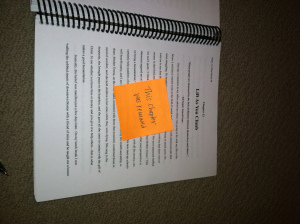
I bound my manuscript and that made it easier to read and them I chose which chapters to delete completely when I needed to cut 12,000 words. No regular routine for me.
Thanks, Kylee!
As part of the blog tour, Kylee is giving away both an electronic and hard copy of her book, a $25 Amazon gift card, and $25 Target gift card. The drawing is a Rafflecopter giveaway, and there are so many ways to earn entries! You can earn entries by commenting on this or any of the other blogs participating in the tour (see the full schedule on The Book Bug); liking the Make It Happen Facebook Page, the Inspire Facebook Page or the Forward Walking Facebook Page; friending Kylee; following either (or both) of Kylee’s twitter accounts: @kyleeshields and @authorkylee; following any of the blog tour hosts on twitter: @GeoLibrarian, @RyanHunter45, @lovingthebooks, @toobusyreading, @LiteraryTimeOut, @jinxtweet, @AnnaButtimore, @MarcusLane14, @walnutspringspr, and @ALSowards; adding Make It Happen to your Goodreads shelf; liking Make It Happen on Amazon; following Kylee’s blog, Kigatsuku; writing a blog post about Make it Happen; or tweeting about the giveaway (once entry per day).
Make It Happen is a collection of principles, blog entries, stories, and conversations had on couches, floors, kitchen tables, and at many single-adult gatherings. It is filled with practical ways to make changes in your life, find hope, increase faith, strengthen relationships, and build the kingdom. The book can be purchased online at Deseret Book and Amazon.
Filed under: Author Interviews


January 3, 2013
My New Maps
I didn’t have a map for my first novel, Espionage. Most of the novel took place in Calais, France, so hopefully it didn’t need one. But when two test readers for my next book suggested I include maps (note: one of those test readers has an advanced degree in military history and the other has a degree in geography), it encouraged me to look into it.
I met my mapmaker, Briana Shawcroft, at a book club meeting I was invited to in southern Colorado. She helped me narrow down concepts and patiently worked with me to get exactly what I wanted. This is what she created:
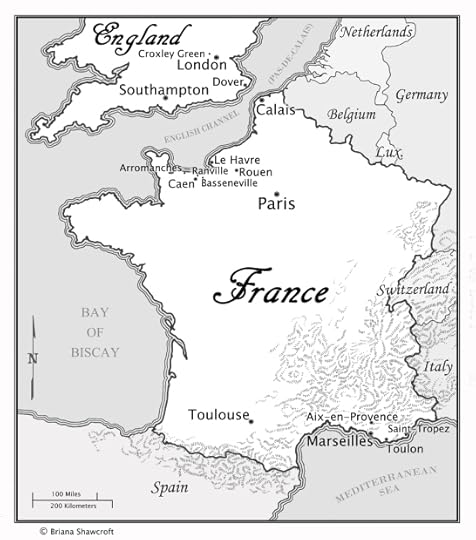
Here’s the map of France.

And here’s the map of Romania.
Filed under: Book 2, History, Writing


December 12, 2012
Typos and Plot Holes: An Ode to Error
For this blog post, I’m going to make fun of myself and some of the crazy stuff I find in first drafts of my novels. I hope you’ll laugh with me. If you want to laugh at me, that’s okay too, just remember I do fix this stuff.
Going through a first draft involves lots of easy fixes: thats that should be whos, weres that should be wheres. A few things are more involved: clarifying a character’s motivation, finding the right balance of action and introspection, getting the word count down to a reasonable level. And some things cause giggles.
Here are a few examples:
Penicillin regiment instead of a penicillin regimen. Can’t you just see row upon row of syringes marching along with M1s slung over their shoulders?
Two liters instead of two litters—because in addition to being unable to walk, the characters in that scene were thirsty. Too bad soda wasn’t packaged in plastic bottles until twenty-five years after WWII.
I’ve had characters play a pick-up game of soccer, and shoot the ball into the net—because fancy goal posts always magically appear when you’re playing soccer, right? Especially if the game takes place on a beautiful British manor.
But by far, the best thing I’ve ever found in a first draft was a disappearing bad guy (and no, I don’t write paranormal). The good guys wrestled his weapon away from him and that was it. No one tied him up. No one killed him. He didn’t come back to try again. He just vanished. Good thing I fixed that, huh?
Of course, there are the inevitable typos that do make it into a final book. In a 100,000 word book, 99.9% accuracy would still result in 100 errors. I can hope for fewer problems, but sadly, my books aren’t perfect. For example, page ten of Espionage is missing a set of quotation marks. There are probably other typos in there too, I just haven’t looked beyond the first chapter. I cringe when I see them, and hope my readers will be forgiving.
So what typos or plot holes have you noticed recently? Did they make you laugh, or cringe?
Filed under: Book 2, Book 3, Writing



